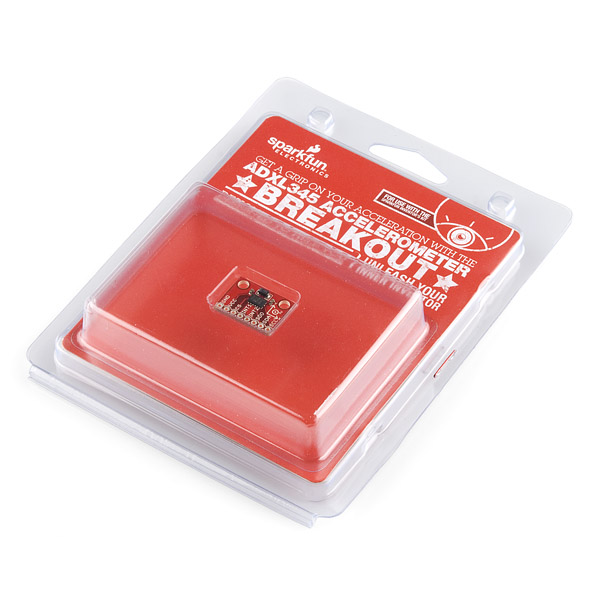Triple Axis Accelerometer Breakout - ADXL345 Retail
This new version adds 2 standoff holes as well as an extra decoupling capacitor. Breakout board for the Analog Device ADXL345. The ADXL345 is a small, thin, low power, 3-axis MEMS accelerometer with high resolution (13-bit) measurement at up to ±16 g. Digital output data is formatted as 16-bit twos complement and is accessible through either a SPI (3- or 4-wire) or I2C digital interface.
The ADXL345 is well suited to measures the static acceleration of gravity in tilt-sensing applications, as well as dynamic acceleration resulting from motion or shock. Its high resolution (4 mg/LSB) enables measurement of inclination changes less than 1.0°.
Several special sensing functions are provided. Activity and inactivity sensing detect the presence or lack of motion and if the acceleration on any axis exceeds a user-set level. Tap sensing detects single and double taps. Free-fall sensing detects if the device is falling. These functions can be mapped to one of two interrupt output pins. An integrated, patent pending 32-level first in, first out (FIFO) buffer can be used to store data to minimize host processor intervention. Low power modes enable intelligent motion-based power management with threshold sensing and active acceleration measurement at extremely low power dissipation.
Note: The package incorrectly advises that this sensor works at 3.3-5 VDC. The correct voltage range for this board is 2.0-3.6 VDC.
- 2.0-3.6VDC Supply Voltage
- Ultra Low Power: 40uA in measurement mode, 0.1uA in standby@ 2.5V
- Tap/Double Tap Detection
- Free-Fall Detection
- SPI and I2C interfaces
- Schematic
- Eagle Files
- Datasheet
- Example Code (ATmega328)
- Bildr Tutorial
Triple Axis Accelerometer Breakout - ADXL345 Retail Product Help and Resources
Core Skill: Soldering
This skill defines how difficult the soldering is on a particular product. It might be a couple simple solder joints, or require special reflow tools.
Skill Level: Noob - Some basic soldering is required, but it is limited to a just a few pins, basic through-hole soldering, and couple (if any) polarized components. A basic soldering iron is all you should need.
See all skill levels
Core Skill: Programming
If a board needs code or communicates somehow, you're going to need to know how to program or interface with it. The programming skill is all about communication and code.
Skill Level: Competent - The toolchain for programming is a bit more complex and will examples may not be explicitly provided for you. You will be required to have a fundamental knowledge of programming and be required to provide your own code. You may need to modify existing libraries or code to work with your specific hardware. Sensor and hardware interfaces will be SPI or I2C.
See all skill levels
Core Skill: Electrical Prototyping
If it requires power, you need to know how much, what all the pins do, and how to hook it up. You may need to reference datasheets, schematics, and know the ins and outs of electronics.
Skill Level: Noob - You don't need to reference a datasheet, but you will need to know basic power requirements.
See all skill levels
Comments
Looking for answers to technical questions?
We welcome your comments and suggestions below. However, if you are looking for solutions to technical questions please see our Technical Assistance page.
Customer Reviews
No reviews yet.





Any one tried free fall detection using SPI?
Updated arduino sketch files please for mega2560R3? Otherwise the documents are pointless for people buying these products..
The Bildr tutorial has the updated code for Arduino 1.0, which should work with the Mega2560R3. Just be sure to wire to the correct pins on the Mega, which are located in different spots than on the Uno shown in the tutorial.
Just wanted to pass on a note of warning with the packaging of this part. On the back of the package (at least the one I received ) it states "It can be powered from 3.3V to 5V and has a multitude...." This is wrong, as the data sheet clearly states that the part has an operating range of 2V - 3.6V.
Yeah, same thing on a retail package I picked up.